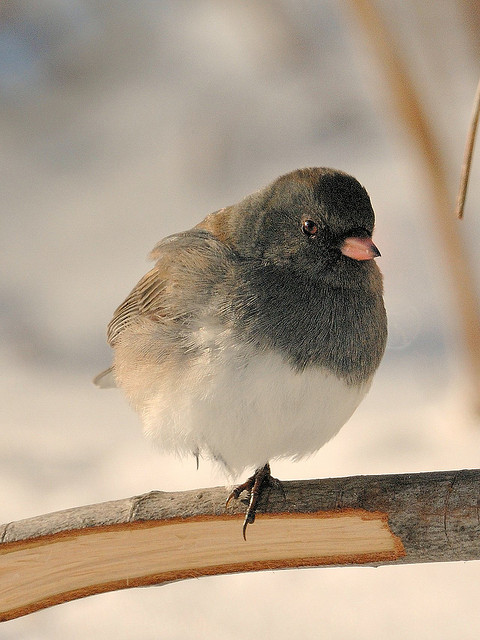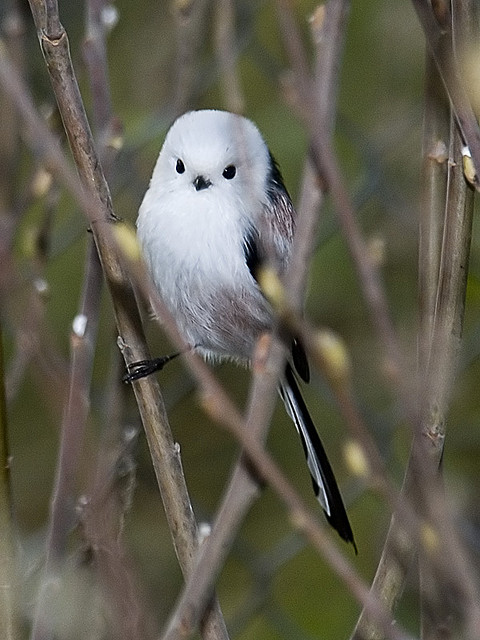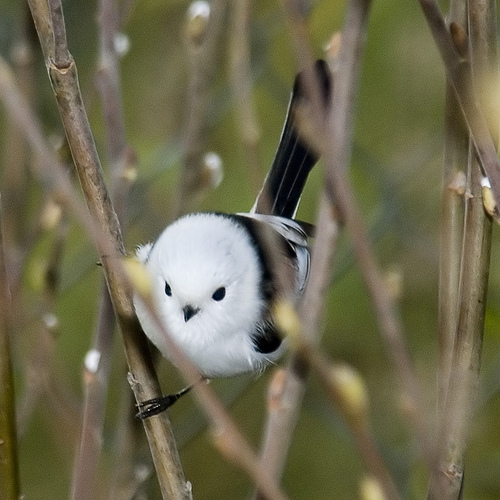I’m currently visiting Chicago, relishing the finger-stiffening, face-numbing cold and wind that make up a proper midwest winter. Whenever I look out from the warmth of my big puffy coat and see a bird, I feel a little bad for enjoying the weather so much. I can go home and make myself hot tea; they can’t.
Like mammals, birds are endothermic (“warm-blooded”), meaning that they maintain their body temperature independent of the outside environment. This almost always means keeping themselves warmer than the outside air. Birds have quite high natural body temperatures, even higher than ours, so any given outside temperature seems even colder to them than it does to us.
Birds are also smaller than we are (well, omitting the ostrich), which means that they have a higher surface-area-to-volume ratio than we do. This is a problem because the volume (inside) of an animal is where heat is produced and stored, while the surface (skin) of the animal is where heat is lost to the environment. Imagine holding your hand in a bitter wind: how would you keep it warm? By making a fist. Making a fist reduces the surface-area-to-volume ratio of your hand, and lets it keep warm longer. In contrast, if you hold your hand out flat with all the fingers spread, your surface-area-to-volume ratio is larger, and your hand will get cold very quickly. Because birds have higher surface-area-to-volume ratios than we do, keeping warm is harder for them. How do they do it?
Feathers: There is a reason why we fill our best coats with goose down. Feathers are fantastic insulation. Downy feathers trap tiny pockets of air next to the bird, allowing the bird to warm those pockets of air and hold that warm air around itself, preventing cold air from touching its skin. The more air trapped, the warmer the bird. Birds fluff up (the technical term for fluffing up is “ptiloerection”) in the cold to trap as much air in their feathers as possible.
The legs and feet of almost all birds are thin and lack feathers, and so are vulnerable to rapid heat loss. Some birds handle this the obvious way:

Dark-eyed Junco at zero degrees Fahrenheit, standing on one leg to tuck the other into her down. Photo by Pete Zarria
Why doesn’t the junco in the photo just sit down on both of her feet to keep them warm? Possibly because she wants to be able to escape predators. Juncos that are fluffed up and sitting on their feet in order to keep warm take more time to fly when startled, compared to sleek standing juncos, making them vulnerable to predators (Carr & Lima 2011). Carr & Lima didn’t study fluffy standing-on-one-foot juncos, but it’s possible that standing on one foot is a more flight-ready position than sitting.
Counter-current exchange: What if you can’t sit on your feet? What if, instead, you have to swish them around in frigid water?
Ducks and gulls can have such cold feet that they do not leave melted footprints in snow. The tissues in their feet are adapted to very cold conditions, and can still function close to freezing (Steen & Steen 1965). Yet if their feet are near freezing, and the blood that circulates through their feet then enters their bodies… those warm insulated bodies are going to cool off very quickly.
They deal with this by using counter-current heat exchange. Veins and arteries in the leg are close to each other, and as warm blood leaves the body, it heats up the cold blood returning to the body.

Crude diagram of counter-current exchange in a duck foot. Red blood is warm, blue is cold; arrows indicate direction of blood flow.
Heat loss is minimized and the duck doesn’t freeze, even if its feet do.
(And if you’ve ever wondered, as I have, whether ducks are warmer on land or in the water: it appears that they lose 22% more heat while swimming than while standing on land in wind. So swimming is colder, but not by as much as you might expect (Van Sant & Bakken 2006).)
Huddling: Many birds, especially small birds, huddle together to conserve warmth (Gilbert et al. 2010). Huddling reduces the birds’ surface-area-to-volume ratio, since it turns many small birds into a single big group, and larger objects have higher surface-area-to-volume ratios than smaller objects.
Long-tailed Tits form single-file roosting “huddles” (lines, really) to keep warm at night. They are tiny, weighing 7-9 grams, and on average lose 9% of their body mass overnight. Energy conservation is crucial for them. The birds on the ends of the huddle lose more mass overnight than those in the middle, so the birds jockey for position, all trying not to be the cold one on the end (Hatchwell et al. 2009).
I once saw a photo of Long-tailed Tits huddling, but I can’t find it now, so here is my (very accurate, really!) recreation of the photo in Powerpoint.
References:
Carr JM, Lima SL. 2011. Heat-conserving postures hinder escape: a thermoregulation-predation trade-off in wintering birds. Behavioral Ecology 23:434-441.
Gilbert C, McCafferty D, Le Maho Y, Martrette J, Giroud S, Blanc S, Ancel A. 2010. One for all and all for one: the energetic benefits of huddling in endotherms. Biological Reviews 85:545-569.
Hatchwell BJ, Sharp SP, Simeoni M, McGowan A. 2009. Factors influencing overnight loss of body mass in the communal roosts of a social bird. Functional Ecology 23:367-372.
Steen I, Steen JB. 1965. The importance of legs in the thermoregulation of birds. Acta Physiologica Scandinavica 63:285-291.
Van Sant MJ, Bakken GS. 2006. Thermoregulation on the air-water interface – II: Foot conductance, activity metabolism and a two-dimensional heat transfer model. Journal of Thermal Biology 31:491-500.









Thanks for the great explanation of how birds keep warm. I definitely learned a couple of things. I really like the first picture, although the long-tailed tits are also very cute.
Reblogged this on TreeMagazine – For People who CARE!.
Thanks!
You are welcome!
Keep it green and Happy 2013! :-)
As usual, wonderful and informative post! I love birds and read up on them, but always learn so much from your posts. Thanks and have a great new year!
Thanks! Happy almost new year to you!
Pingback: Long-tailed tits, owls, and flowers | Dear Kitty. Some blog
Love it! You do a great job writing and presenting the complexities of the living world. We can learn so much from our feathered friends!
very interesting information, and great photos.
Thanks for the thorough explanation of how birds keep warm in frigid temps. Yours is an informative blog and will keep me coming back!
ALWAYS fascinating and informative… Thanks so much! And timely, too. As I’m here visiting in the north (from FLA), I was just telling my brother last night about how I’ve read bits of how these guys stay warm, but as the cold and wind are whipping me to the bone, I’m uttering “how, how, how, how….” :)
I still sometimes look at birds and think “Okay, downy feathers, tucked-in feet, huddling, generating metabolic heat… but how are you REALLY still alive??” It’s amazing what they can handle!
DITTO. One can understand the process… But the cold. Oh, the cold! For such seemingly delicate, diminutive creatures — they’re tough little birds (hee hee!)….
Nice post! Really interesting scientific information and well-written for us non-scientists. It’s very valuable skill to have these days, when so many people are adverse to actual information. Lovely photos, too and I love that you are studying juncos… I just painted a little Christmas painting featuring those little guys!
I love the Junco standing on one foot! Why don’t Juncos find a warm nest in a pile of leaves or under some branches out of the wind? Why don’t birds cluster in nests the way small mammals do? (I guess that is how the green parrots in Hyde Park stay warm: they gather in one large nest, right? But it’s in a tree.)
Non-breeding birds usually don’t sleep in nests because it’s dangerous: predators can find the nests, and the birds can be trapped inside. Breeding birds are often killed in the nest. Our wild Monk Parakeets are different partly because their nest is a giant communal thing with many exits, so even if it increases the chances of predators finding them, they have neighbors to warn them and many escape routes. (And since the parrots aren’t native to cold climates, the big nest presumably didn’t evolve for warmth, but was co-opted for that. I wonder if the parrots would still survive in Chicago if they couldn’t roost in a nest? I bet they would.)
In researching to answer this question I found enough info that I’m going to write another blog post to fully answer. The short answer, though, is: birds actually do take shelter at night for warmth, it just doesn’t really look like shelter to us. You know how you hear flocks of House Sparrows chirping from the denser bushes all around Chicago this time of year? Those bushes are sheltering them, even though they’re just bare branches.
What a great post! Very interesting.
Great post! It reminded me of a drawing by Bernd Heinrich–almost certainly in his book Winter World–where he sketches a sort of cutaway view of a golden-crowned kinglet. He’s drawn it as if half-plucked, so you can see the tiny, tiny body of the kinglet–barely larger than a bumblebee–within the fluff of the feathers. Besides the difference between body-size and feather-surface-size, that drawing also underscored how birds alter their silhouettes by fluffing or sleeking their feathers in different ways.
I’ll have to look that up, thanks for mentioning it! It is amazing how feathers change the shape of a bird. Not only are they much smaller under all that fluff, as you say, but the relative sizes of everything are different: wings are thin and stubby, and the head is a huge heavy ball attached to a looooong thin dinosaur neck.
Yes. I’ve always been struck by how very chicken-like birds all seem to be, once they’re stripped down.
A great educational post, Katie. Happy New Year to you.
Thanks! Happy New Year to you!
Very good post with great pictures too!
Pingback: Could ducks in the water melt ice? | Tough Little Birds
Pingback: If You Give a Bird a Shower | Oiled Wildlife Care Network Blog
Pingback: Birding with Daniel at Lake Braddock | branchbrioso
Pingback: 16+ Pics Of Birds Cuddling Together For Warmth Will Melt Your Heart | ReBlog Ninja
Pingback: Renklim Blog – Burada renkli bir şeyler var! – Kuşların dünyasından 18 muhteşem kare
Pingback: Kuşların Birbirlerine Sarılarak Çektirdikleri 20 Harika Fotoğraf « Magsuz.com Sosyal İçerik Platformu
Pingback: 16 Fotos de pájaros acurrucados que a tí también te darán calor | AltaMental
Reblogged this on wil's blog .
Pingback: 16 Images Of Birds Necking Together For Warmth To Attach Your Heart | Welcome to Mysamnang!
Great blog! I also love the photos!
Thanks so much! I like your username :-)
You are welcome and, I like my username too ;)
I have watched several juncos today. They keep winning space (the nuthatches challenge them), on my deck, where they are enjoying seed and suet.
I have a problem why is the birds puff there body before sleeping?
Pingback: How do birds keep warm? – NEWS Travel Girl
Pingback: What are the winter chicken care mistakes I should avoid?